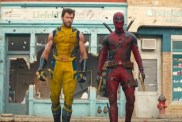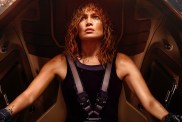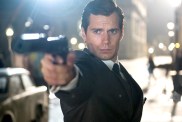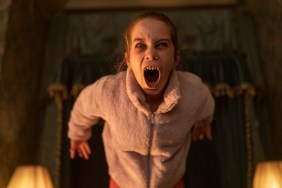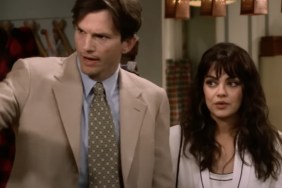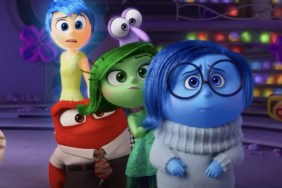Just as the full trailer for Arthur Christmas hits this week, Sony Pictures Animation is preparing to deliver the highly ambitious project this November 23rd and, if the opening 30 minutes are any indication, animation fans young and old should have a real holiday treat on their hands.
Directed by Sarah Smith and produced through Aardman Animations, Arthur Christmas attempts to answer childhood questions about Santa Claus and how it’s possible for him to deliver presents to billions of people on just one night. We’re introduced at the beginning to something akin to a royal family with Santa Claus being the title given to the current reigning member.
The current Santa (Jim Broadbent), while nevertheless a jolly soul, is getting on in years and his eldest son, Steve (Hugh Laurie) is calling most of the shots from a high-tech base at the North Pole. He’s anticipating his father announcing that he can now take over the Santa Claus title this year while his younger brother, Arthur (James McAvoy), is content to just answer letters from all the good children of the world. Meanwhile, Steve and Arthur’s grandfather, Grandsanta (Bill Nighy) lives with them all and steals most of the scenes as a cantankerous and decidedly non-PC senior citizen.
Beginning on Christmas Day, we get to see the delivery process and the involvement of a million specially-trained elves who depart with Santa on a massive flying vessel, the S-1, to hit every house on Earth in the same night. Steve oversees the mission from his control station and, if there’s a problem, instructs the elves on how to overcome it.
Unfortunately, something goes particularly amiss and a single present isn’t delivered to a good little girl. With just hours to go before sunrise, Grandsanta ends up setting out with Arthur on his original, reindeer-powered sleigh in an attempt to save the day.
In addition to top-tier animation, Arthur Christmas refreshingly avoids some of the cliches of animated films, building the story from minor quibbles within a family dynamic rather than offer up any kind of tangible villain. Smith spoke with ComingSoon.net about her original vision for the project and the intense work that has been done over the past five years to bring Arthur and his family to the big screen.
Q: We saw so many details as far as the elves go. How many versions did you do?
Sarah Smith: Well, we have a complete numbers plan that Pete [Baynham] and I worked out where we tried to figure out exactly how many elves it would take. There are supposed to be one million field elves in 330,000 individual teams. There are three different types in each team with a whole different ranking and order of elves. In the mission control, there are 10,000 workstations for elves. Of course, there are a number of hero elves and the rest are generated by a character variation system. They designed about 15 different skin tones, 20 different hair styles for male and female, different body types, head shapes and so on. Then they effectively go through a massive program that generates them. Then I go through and go, “That doesn’t look like an elf. That doesn’t look like an elf.” You just select your kind of heroes. I did drive everyone completely insane with elves for a while because they’re just a small part. There’s so many other details in the movie. But we had a whole plan of who does what and how it all works. Actually, there’s something in the film that no one in the world will ever see where, on their arms, they have badges according to what area and unit and division they work in. Sometimes, they’d be showing me shots with so many other complex things and I’d be saying, “Wrong color hat!” or “He shouldn’t be wearing that shirt!” We wanted it to be quite in-depth, though, because when you’re trying to present a whole alternative world, you need to really know it yourself. Even if you’re just showing a glimpse of it to a kid, you need them to think that, yeah, it could be real. In order to give that impression, though, you need to work out the rules of your world in huge detail which, in my case, was down to the badges. They all say “wrapping division” or “communications” or “S-1 Support.”
Q: That seems like the perfect example of how long it can take to attempt something like this. When did “Arthur Christmas” begin?
Smith: It started about four-and-a-half years ago. I was actually just at Aardman for six months to work out a slate of films for them. This one came to me from Pete, who is my very long-term friend and collaborator. We worked together before. I told him I was going to be at Aardman and asked if he had any ideas. He said, “Yeah, I’ve had one of my best ideas ever!” and he pitched the two-minute versions to me. Because it was Pete, as I started working on it with him, I just totally fell in love. It became our giant baby and we worked on the script for a year-and-a-half to two years. It’s been in production for about two-and-a-half years now.
Q: In animation, there’s always a lot of tweaking with the storyboards and whatnot with vast sections being rewritten. How many iterations did “Arthur Christmas” go through?
Smith: We were actually sort of unusual because I don’t come from an animation background. I come from live action and I’m a very big script person. I believe in scripts. We didn’t go the storyboard route. We had no story team for the first year. Pete and I wrote drafts of the script and worked it and worked it on paper for a long time. The fundamentals of the movie never really changed. The middle of the movie — which is the point at which you just left — becomes a crazy road trip with the old sleigh out in the modern world, not really suited and equipped for the modern world. It’s sort of like the North Pole waking up the fact that there’s something going on out there while the rest of the world wakes up to the fact that there’s something out there. They don’t have an anti-radar device and get picked up by air traffic control. The world thinks it’s a UFO and there’s a whole adventure. They get blown off course and there’s a whole trip around the world to Africa and Mexico. That part of the movie was the most malleable, because we had the problem of being able to go absolutely anywhere in the world. In fact, they do go everywhere in the world and even to space at one point. It’s very hard to select that down to the number of sequences that you want. You can have the sleigh go anywhere and have anything happen. But the beginning of it – the idea of showing the mission and showing that something has gone wrong, the aftermath with the family and showing the old sleigh and then the end part of the movie when they finally arrive – that’s always been exactly the same. We did go through several drafts of the script and we did end up at a storyboard process, of course. I guess we did about three passes on that. The scenes that get most affected by storyboards are actions sequences, really. What you write kind of changes as you discover visual jokes.

Q: When it comes to Aardman projects, there’s a nice split between a CGI film like this and the more traditional stop-motion. Did you know from the onset that this one was going to be computer animated?
Smith: Yeah, because, while Aardman has always been thought of as a stop-motion studio, they’ve always done a whole range of different things. It’s all about what fits the story. This would never have fit in stop-frame because it’s a high-tech world and it has a million elves. You want that scale. You want that feeling of something spectacular and high-tech. You want that feeling that it’s our real world. My whole thought on how the world should be is that it shouldn’t have a strong-skewing design choice. I wanted it to feel like it’s the world as every kid knows it. Where the little girl lives is a very average housing estate. They go to gas stations and all the things that kids would recognize but put through the filter of how a children feels on Christmas night. How, as a child, you lie in bed on Christmas Eve and you know the world outside your window is the same, but somehow you feel it as a sort of heightened, sparkly magical thing. That was the idea. To do something that had that much scope and scale. Even things like flying are not really stop-frame things to do. I think stop-frame works best with contained worlds. “The Pirates!” actually has great scope, but they’re using CG to give them more scale. At the heart of it, though, is the pirates on the pirate ship and that’s a fabulous thing to do in stop-frame.
Q: Something that’s great about what we saw is the adult level of humor.
Smith: I guess Grandsanta is the carrier of an awful lot of that. I think that I never really think of writing for kids. Well, that’s not entirely true. We wanted to be very respectful of what kids believe about Christmas. We have elves doing a lot, but some kids really want to feel that it’s Santa in their homes. So we show that Santa does deliver some presents. We try to make sure that we weren’t stepping on what kids want to believe about Christmas. So we did write for kids with that in mind but, outside of that, I’m totally with the Pixar kind of mantra where you just have to write it for yourself. You have to make yourself laugh, because otherwise you’re patronizing your audience. Children are unbelievably sophisticated. You watch “The Simpsons” with a seven year old and get all the jokes. And if they don’t get every one, they like the fact that there’s something more to reach for. So we write it for ourselves and to make ourselves laugh. I guess particularly Grandsanta is in that kind of vein. He’s sort of the naughty grandparent who actually says out loud what everyone else is thinking. He’s basically my grandfather (laughs).
Q: There’s a big family dynamic that’s very accessible, even though we didn’t see the full backstory. Was that something that was very fleshed out in advance?
Smith: The idea was basically that there’s this traditional Christmas myth of Santa and I think that is slightly confusing for children when they try to work their way into it. “I’ve heard about Saint Nicholas. Is that the same Santa?” Once you start to go there, it gets a bit tricky to hold it all together. Our argument was basically just that, of course, even if you haven’t seen it, the Santa operation would have had to have moved on throughout the years. We wanted that to be a positive thing. It’s not a negative thing. It’s like, “Wow! They’ve kept up. They really can do two billion presents!” What would it actually take to do that? Part of that is he idea that Santa has changed over the years. Once it was Saint Nicholas with a donkey, but what would it be today? That means that you’re into the idea of a family and succession and so on. Our thought of the current Santa is that he’s a lovely, benign Santa, but it’s such a lovely job, why would you want to give it up? It’s kind of like being President for so many years and having stop. And he’s been it for so many years that he kind of has that moment where he goes, “Who would I be if I wasn’t Santa?” Steve is supposed to be like the architect. It’s a very classic family business scenario. He’s the one with the ideas and has actually managed to keep them going. Without him, how would they have kept it up? Santa is now just incredibly busy and slightly exhausted and therefore doesn’t quite have enough time for his own children. He hasn’t quite paid enough attention to them. Not out of anything callous, but he’s in a world where he’s a father figure to two billion children. What does that mean if you’re actually Santa’s own kid. Steve is supposed to be that incredibly bright overachiever. He’s never quite been noticed and his dad has never quite paid enough open attention and gone, “Well done! You did that!” That’s all he really wants. There is a moment later on in the film where Steve gets very upset and his inner kid comes out. He says, “Oh, that’s right! You don’t care about the two billion things I did right tonight! You just want to focus on the one thing I did wrong!” Santa looks at him, bemused and says, “This is about that pool table, isn’t it?” There’s this whole backstory where Steve was seven and Santa says, “You should have written to me!” and he says, “But you’re my dad!” It’s that awkward thing where, what are you going to do if your dad is Santa? He’s like the child of an icon or someone incredibly famous. It’s a problem for both Steve and Arthur. What would it be like if your dad was Santa?
Q: Can you talk about finding the voice talents?
Smith: I always thought of the Santa family as being like the British Royal family, really. So we kind of looked at the British Royal family as a starting point. Jim Broadbent, to me, was key. It’s very hard casting Santa and one of the reasons why, when Pete told me this idea, I thought it should be animation and not live action. Because as soon as you put a famous actor in the part of Santa, it distances you from it and, in a funny way, it’s easier to believe it’s real when you see it in animation. But Jim Broadbent, to me, is just so perfectly benign. If you were a kid and you woke up and it was Jim Broadbent, that would be fine to see him in your room delivering a present. Imelda Staunton has that marvelously self-contained army wife thing. James McAvoy, I looked for Arthurs for a long time. In fact, we were looking around for people who then all got fantastic careers like Andrew Garfield, who’s going to be Spider-Man and Matt Smith, who became Doctor Who. Somewhere along the line, I saw that film James McAvoy did, “The Last Station,” where he played a much younger character. I just thought there was something about him. He’s such a livewire. I think he’s one of the interesting people as far as casting goes because he’s very different, as far as age and the look of his character, from what he’s playing. Yet, to me, when I hear the voice, it belongs to Arthur and not to James. Whereas Jim Broadbent sort of is Santa, you know? For Grandsanta, my original thought was to go after my comedy heroes who are now in their Grandsanta years, as it were, thinking I would cast one for them. I kept looking for that sort of roguish spirit and Bill Nighy just has that in spades. He’s just naughty in a fun way. He’s someone that you would want to spend a movie with. You want him to be your wicked granddad. The idea there is that, while he’s a tiny, frail old man, he’s got this massive energy and spirit to him. Bill does that fabulously.

Q: There’s something interesting in the footage we saw that sort of jumps outside the normal story format. There’s not a straightforward villain and there’s not really a romantic interest.
Smith: Oh no! We forgot! (Laughs) Peter ran me up in the first year and said, “I think we need a villain! What if we have this evil elf?” He was going to be called General Antler and he wanted to make burgers out of the reindeer. He sent me something and it was like “The Killing Fields.” I said, “Pete? Is this really what you mean? I don’t think so.” But mostly I felt that you need to write something that feels true to you and the thing int he movie to me is that it isn’t really evil that’s wrong with the world today. It’s the evil of slightly kind of not getting it. Steve is sort of the baddie because he just doesn’t get it. He’s running Christmas, but it’s for all the wrong reasons. Later on, he storms in and finally says, “Alright! So I’m not good with children. Does that make me bad Santa?” There’s this sort of little silence. That’s the bigger problem in the world today. It’s not so much about evil things happening, it’s just the sort of crapness of things not happening for good reasons.That’s sort of the worst thing that happens all around us and that’s what Steve embodies.
Q: This is being released in 3D. Can you talk about prepping it for the format and any challenges you had to overcome going that route?
Smith: We knew right from the beginning that it was going to be in 3D. There were some really, really hard choices. I’m not a 3D expert and had to learn a huge amount about what works and what doesn’t. Often what you would shoot for 3D is the opposite of the choice you would make for 2D. For the home elf invasion sequence, I always wanted to do a sort of Paul Greengrass handheld camera thing, which is really hard to do in animation anyway with very fast cuts and moving cameras and so on. That doesn’t lend itself to 3D, so there’s an immediate challenge with two different aesthetics. But it doesn’t kind of work for what kids think is cool in action. Having said that, there’s a huge amount in the movie that I think is spectacular in 3D. It all came out of the world we had designed rather than change things for 3D. We don’t have anyone poke you in the eye for example. One of the things that’s great for 3D, though, is how detailed and tactile the world is. If you see the sleigh barn sequence in 3D, it’s fantastic because you feel you’re walking in this gorgeous, detailed 3D world. Arthur’s office is the same. It’s full of little details that have some physicality in 3D, which is brilliant. The other choice we made early on is when they go out on the sleigh. I wanted it to be like a road movie. Rather than have big, sweeping camera movements, we actually attached them to the sleigh on mounts in the computer. That actually makes those sense fantastic for 3D because, visually, you’re anchored to the sleigh and it feels like being in the car of a roller coaster. You’re on the ride because you’re inside the sleigh. The other thing that’s fabulous in 3D is Mission Control because it’s the biggest set you’ve ever seen and it has fantastic lines of perspective from the camera right into the distance. The background is a big 2D screen, which makes the perfect 3D design. There were some things where we had to make the decision about the 2D or the 3D and which was going to take the lead, but a lot of it has the 3D process opening it all up in a really brilliant way.
Q: Once the script was locked down, how long has the actual production taken?
Smith: The pre-production, based on the approved script before storyboards, had about a year and a half in Bristol. We managed to do the whole kind of creative setup of it here, which was brilliant. We had a lot of time and space and secrecy to kind of work it out. We did design and storyboarding in Bristol for about a year and a half. Then we moved to Imageworks in LA and did about a year and a half in animation shot production. The animation is just ridiculous. There were times I wanted to run into the animators and go, “Do you know you can get actors and they can walk on their own!” (Laughs)
Q: You had a co-director on this. Is there a certain technical aspect that one of you takes on over the other.
Smith: I basically directed it. I had a co-director for a period of time because I was pregnant and had a baby, but, in fact, the last two years I’ve done on my own. I mean, it’s fantastic to have support, especially early on in the process, but it had sort of been mine and Pete’s project at the very beginning and, in some ways, it’s a nightmare trying to do it on your own. It’s just such a giant amount of work and there’s so many people to interact with. But in other ways, it’s kind of easier. You carry the idea of it and you can make it coherent. You don’t have that difficulty. My relationship with Pete is really the strongest one in that we’ve known each other for 20 years. We argue about absolutely everything, but it’s from the standpoint of basically agreeing about everything. You’re arguing about the best way of doing it or the best detail. You can’t turn that relationship on. That comes from knowing someone for years and years and years. Pete’s been a good touchstone for me all the way through. I couldn’t really create that with a different director, because it’s such a hard thing reaching those different points of view. So once we went to America, I ran with the thing myself.
Q: Aardman has a lot of familiar characters. Are there any Easter eggs that fans should be on the lookout for in “Arthur Christmas”?
Smith: Yes, in Gwen’s bedroom, she has a “Shaun the Sheep” backpack and a “Chop Socky” poster as well, I think. There’s also a “Shaun the Sheep” squeaky toy that gets trodden on and there’s one in the bit you saw that’s a tiny homage to “The Wrong Trousers” where an elf is laying the some track for a railway track toy.

Q: This seems like a film that embraces the international side of Christmas. Was there anything you came across as part of a country’s Christmas tradition that seemed a bit bizarre to the way American or British audiences know the holiday?
Smith: Yeah, that was really hard, actually. We did research Christmas traditions and you’re suddenly in front of an exhibitor from some country who goes, “But we celebrate Christmas on the fifth of December and we don’t get presents on that night!” So, to some extent, we had to put a slightly colonial view, which makes it universally the 25th of December. Santa comes the night before and that’s how it goes. It was the same argument we had earlier on — and I think it was the most heated row that Pete and I had — was a few days into the story development, where we discussed the idea of featuring time zones. If they’re chasing night, Santa could suddenly have not just ten hours to deliver presents, or whatever it is. It seemed so fantastic, but then we realized that gets so complicated. Also, for a Christmas movie with a countdown — where they’ve got to get this present there before dawn — it’s very important. Of course, in our world, no child wakes up for Christmas before dawn. Their deadline is that they’ve got to get this present in the last two hours before the sun comes up. If you were flying between timezones and suddenly landing in Africa with the sun up, it would completely ruin your jeopardy. We decided, okay, for kids, Christmas night is night. They don’t start thinking about the fact that, in Australia, some kid is already awake. We wanted to preserve the magic of that idea.
Q: Was there discussions about balancing the parents giving their children presents, too?
Smith: We didn’t particularly feature that, no. We had a bit, at the beginning, where there are already presents under the tree and there’s a bit of parents being awake. But in the movie, they go to so many different places. They end up in Africa and are singing silent night to the lions. After that opening of houses, there is one more house that gets visited, but they’re really already in this sort of big world trip. One of the things we wanted was to make sure we weren’t saying that the old ways or the new ways were bad. We didn’t want to say that the old sleigh, with the original reindeer was the answer, because, while you do love it and it’s gorgeous, you realize that it’s impractical. How could that deliver all those presents. The point is about why you do it and not how you do it.
Q: Do already plan for the DVD or Blu-ray release as you’re in production?
Smith: We are, but it’s going to be for next Christmas. It’ll be released and then we’ll add some extras to it.
Q: Does that give you more time to add features like short films?
Smith: Yeah, I hope we will. There’s just no way we could have gotten it together before this Christmas as well. It’s been such a tricky deadline because delivering two weeks late on the movie means a next Christmas release.
Q: Were there any scenes in particular that got pulled out that you liked?
Smith: Well, in animation, it’s so expensive that you don’t really have deleted scenes. That’s the whole point of the storyboarding. You see that early on and you end up having to commit. There were versions of scenes and little extra bits here and there that we trimmed, but not a huge amount. But there are deleted scenes and extra scenes in storyboards. Those might be included in the DVD version.
Q: In terms of the character design, did you make a conscious effort to move away from the style of “Wallace & Grommit” and “Flushed Away”?
Smith: My aspiration for the character design was, yes, not going the “Flushed Away” route of trying to copy the stop-frame look. That was my choice. I think that Nick [Park] is one of the best character designers in the world. People don’t think of him like that, but I think he is. I think one of the things that makes his movies spectacular is his characters are fantastic. But, to me, they totally belong to Nick and they belong to stop-frame. So, in the end, I wanted them to still look like they could have only come from Aardman and that they belonged to the family. I think they do. I don’t think they look like CG human characters from other studios. We didn’t try to make any of them cute, particularly. They weren’t trying to look appealing. They are themselves. They have a slightly rough and ready look to them. For instance, for Grandsanta we looked at very early thing Pete Lord had done with an old man. It had that fantastic, slightly-crumpled old man look from plasticine. That was one of the inspirations for Grandsanta. Our characters are quite asymmetrical. They’re just really themselves. We started drawing how we felt about them as characters and then just developed them into a kind of shape language. In the end, when I look at them, I do feel they look like Aardman characters. Grandsanta, especially, has a sense of imperfection as well. They feel sort of British and quirky. They’re not airbrushed. For Arthur, I wanted him to appealing, but really not cute. I don’t think he is. When you look at him, facially, he’s quite odd looking. But I had the idea of giving him very soft hair that would make you want to pat it. Also, the slippers. We wanted to give a terrible Christmas sweater and Christmas slippers. We made the slippers really soft and furry and there’s something about him that makes you say, “Bless.” He’s obviously a mess and wears sort of terrible sweatpants with baggy knees and stuff like that.
CS: There’s something about Christmas movies that’s great, sort of going with what you mention about the DVD, where they become timeless and something that gets watched every year. Was there anything that you added or removed to the story to make sure that it could fit in that timeless sense?
Smith: That’s really hard. The technology thing is really hard. Because it moves on so fast. We have the Ho-Ho 3000 and also the Ho-Pad that came about after the iPad was released. You’re very aware that that stuff changes and that it can potentially date you. But there’s nothing you can do. You place your graphics and your things in a slightly timeless place and hope that you don’t look dated in ten year’s time. But it’s really, really tough. Also, it’s kind of hard doing technology in animation. The last time I saw that was in “WALL-E.” They chose a very simplified look in their graphics and so on. We chose to go a little bit further and make them somewhere between that and “Minority Report.” We actually had even cooler graphics at one point, but I realized that you needed the kid element in it to make it funny. It’s the cool offset by the ridiculous. They’re taking so seriously slightly regular things. But who knows? Technology in five years time may have not even have computer terminals. We may just have glass screens. But I hope not because, as you say, the aspiration for a Christmas film is that it becomes something that lasts. That people will love beyond one year.
Arthur Christmas hits theaters in 2D and 3D on November 23rd.
